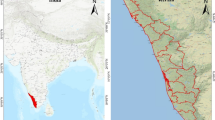Abstract
This paper reports the results of an exercise on the development and application of a rule-based software program,Combine for integration of thematic information in simplest possible way. The program was used for forest land use planning in a shifting cultivation area in north-east India. The program can integrate 28 thematic information layers with upto 256 classes in each layer using 8-bit data. Additionally the software can be used for many per pixel image processing operations like merging of digitally and visually classified images, merging of a large number of thematic classes into a few wanted ones, density slicing, image thresholding etc. conveniently.
Similar content being viewed by others
References
Champion H G and Seth S K (1968).Revised Forest Types of India. Government of India Publications, New Delhi.
Deekshatulu B L (1993). Operationalisation of remote sensing in India.Proceedings 15th International Symposium on Operationalization of Remote Sensing, 19–23 April, Enschede, The Netherlands.
Gugan D J (1993). Integration of remote sensing and GIS.Proceedings 15th International Symposium on Operationalization of Remote Sensing 19–23 April, Enschede, The Netherlands, pp. 77–85.
Hellden U, Olsson L and Stern M (1982). Approaches to desertification monitoring in Sudan. In:Satellite Remote Sensing in Developing Countries (eds. N. Longman & G. Levy), European Space Agency, Paris, pp. 131–144.
Johnson C A, Detenbeck N E, Bonde J P and Niemi G J (1988). Geographical information system for cumulative impact assessment.Photogrammetric Engineering & Remote Sensing, 54(11), 1609–1615.
Kalensky Z D (1992). FAO remote sensing activities in environmental monitoring and forest cover assessment in developing countries.Proceedings Seventh Congress of the ISPRS, Washington D.C.
Kienzle K R (1989). Kalkuel — Universal programming system for pixel-wise processing of digital images.Users Manual. Abteilung Fernerkundung and Landschafts informations systeme. Albert-Ludwigs-Universitaet, Freiburg.
Kushwaha S P S and Madhavan Unni N V (1989). Hybrid interpretation for tropical forest classification.Asian-Pacific Remote Sensing Journal, 1(2), 69–75.
Kushwaha S P S (1993). Applications of remote sensing in shifting cultivation areas.Technical Report, Abt. Luftbild. Inst. fuer Forsteinrichtung, Universitaet Freiburg, Germany.
Kushwaha S P S, Kuntz S and Oesten G (1994). Applications of image texture in forest classification.International Journal of Remote Sensing, 15(11), 2273–2284.
Marble D F, Peuquet D J, Boyle A R, Bryant N, Calkins H W and Johnson T (1983). Geographic information system and remote sensing. In:Manual of Remote Sensing (ed. R.N. Colwell), American Society of Photogrammetry, Falls Church, Virginia.
Marsh S E, Walsh C F, and Hutchinson C F (1990). Development of an agricultural land use GIS for Senegal derived from multispectral video and photographic data.Photogrammetric Engineering & Remote Sensing, 56(3), 351–357.
Nellis M D, Lulla K and Jensen J (1990). Interfacing geographic information system and remote sensing for rural land use analysis.Photogrammetric Engineering and Remote Sensing, 56(3), 329–331.
Ramakrishnan P S, Toky O P, Mishra B K and Saxena K G (1981). Slash and burn agriculture in north-eastern India. In:Fire Regimes and Ecosystem Properties (eds. H. Mooney, J. M. Bonnicksen, N. L. Christensen, J.E. Lotan & W.A. Reiners),U.S.D.A. Forest Service General Technical Report No. WO-26, Honolulu, Hawaii.
Ramakrishnan P S (1993).Shifting Cultivation and Sustainable Development: An Interdisciplinary Study from North-East India. Oxford University Press, New Delhi.
Schmitt G (1990). Thematische Kartierung groessraeumiger tropischer Waldgebiete durch verbesserte Methoden der Ausvertung digitaler satellitenbilder.Dessertation, Albert-Ludwigs-Universitaet, Freiburg.
Shelton R L and Estes J E (1970). Integration of remote sensing and geographical information systems.Proceedings 13th International Symposium on Remote Sensing of Environment, Ann Arbor, ERIM, Michigan, pp. 463–483.
Simonett D S, Smith T R, Tobler W, Marks D G, Frew J E and Dozier J C (eds.) (1977). Geobased information system impacts on space image formats.Technical Report No. 3, University of California, Santa Barbara.
Smith A Y and Blackwell R J (1980). Development of information database for watershed monitoring.Photogrammetric Engineering and Remote Sensing, 46, 1027–1038.
Tomlinson R F (ed.) (1972). Geographical data handling.Proceedings UNESCO/IGU Second Symposium on Geographical Information Systems, Ottawa, Canada, P.3.
Welsh R, Remillard M and Alberts J (1992). Integration of GPS, remote sensing and GIS techniques for coastal resources management.Photogrammetric Engineering & Remote Sensing. 58(11), 1571–1578.
Author information
Authors and Affiliations
About this article
Cite this article
Kushwaha, S.P.S., Oesten, G. A rule-based system for forest land use planning. J Indian Soc Remote Sens 23, 115–124 (1995). https://doi.org/10.1007/BF02995699
Received:
Accepted:
Issue Date:
DOI: https://doi.org/10.1007/BF02995699




